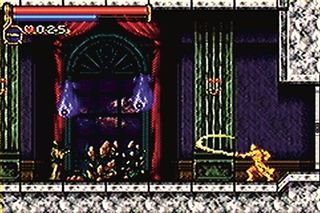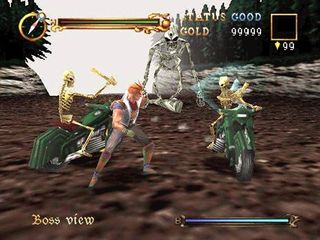1796
Richter Belmont disappears.
1797
Under the control of the wizard Shaft, Richter joined Dracula in the count’s stronghold, causing a shift in the balance of power which awakened Alucard from his slumber. Along with Maria Renard, Alucard lifted Shaft’s control on Richter, tracked Dracula through a bizarre inverted castle and put the count down for the last time in the 18th century.
Castlevania: Symphony of the Night (PlayStation and Saturn, 1997)

Koji Igarashi’s reboot of Castlevania is a direct sequel to Rondo of Blood, and borrows some elements from the original MSX game, some more from Simon’s Quest, and almost everything from Nintendo’s Metroid games. Symphony’s non-linear adventure set the standard for every 2D Castlevania that followed on the GBA and DS, but is still the best game ever to bear the Castlevania name.
Early 1800s
In the absence of descendants of the Belmont clan, the Order of Ecclesia is formed to prevent Dracula from rising again. The Order absorbs magical glyphs to imbue their bodies with power, though the most powerful glyph – Dominus – is stolen from its bearer Shanoa by the jealous Albus. Confronting and defeating Albus, Shanoa discovers he had tried to protect her from the power of the glyph and that the true threat was the Order’s leader Barlowe. Barlowe gave up his life to summon Dracula, once again reviving the Count. Shanoa faced the vampire and was victorious, saved at the last moment by the spirit of Albus.
Castlevania: Order of Ecclesia (DS, 2008)

The third game and most recent offering from Koji Igarashi’s DS Castlevania team, Ecclesia is the best Castlevania since Symphony of the Night but is so preposterously difficult one editor broke his DS Lite by tossing it at a wall during a particularly taxing boss fight.
1820
Dracula sealed away by Morris Baldwin and the parents of Nathan Graves.
1830
Vampire hunter Morris Baldwin and his apprentices Nathan Graves and Hugh Baldwin arrive seconds too late to stop the priestess Camilla from resurrecting Dracula. Cast into a pit beneath the castle, it falls to Nathan to rescue his master and friend, and to defeat Dracula. He does so using his ‘Hunter’s Whip’, which apparently possesses the same powers as the Vampire Killer; it’s perhaps for this reason this chapter of the story had been excised by Koji Igarashi until it came bundled with 2006’s Portrait of Ruin.
Castlevania: Circle of the Moon (GBA, 2001)

The first 2D Castlevania since Symphony of the Night, but not a true sequel to the Playstation and Saturn game. Still, it lifts Symphony’s structure, firmly establishing what all future Castlevanias would become.
1844
Dracula is prematurely dragged back to life by cultists and requires a new body to inhabit. Among the children his acolytes abduct is the surname-less Ada, sister of man-beast Cornell. Following her scent to Dracula’s castle, Cornell defeats the count but fails to end his life decisively. Like the events of 1830, this chapter had been edited from Castlevania history until being restored in 2006.
Castlevania: Legacy of Darkness (N64, 1999)

Both a remake of and prequel to Castlevania 64, Konami’s second 3D hatchet job recycles locations and graphics from the original and supports the N64 RAM pack for sharper visuals, with the side effect of a dramatically reduced framerate. Vampiretastically dump.
1852
Though he lost the name, Reinhardt Schneider carries the blood of the Belmonts and goes in search of children missing from the town of Wallachia. With the Vampire Killer whip he defeats Count Dracula, putting him down until his scheduled resurrection in 1897. This chapter was also removed from official continuity for a time, until Koji Igarashi reconciled its place in Castlevania lore.
Castlevania 64 (N64, 1999)

Officially named ‘Castlevania’, the unofficial nickname differentiates it from the NES original – important because Castlevania 64 is crap. Mario and Zelda made an elegant transition into 3D whileCastlevania collapsed into a smudgy, barely-controllable mess.
1897
Bram Stoker’s Dracula is accepted as Castlevania canon, with a handful of critical revisions. The count takes English solicitor Jonathan Harker as his guest, intending to purchase land in London to be among millions of British civilians. Harker’s friend Quincey Morris, who is of Belmont lineage, eventually kills the count with a stake to the heart, but succumbs to his own injuries at the hands of gypsies charged with the care of Dracula, leaving behind a son, John Morris.
1914
Archduke Franz Ferdinand of Austria is assassinated, triggering the First World War.
1917
Twenty years after the death of Morris, the soldiers massacred in The Great War are harvested by Elizabeth Bartley, niece of Count Dracula. Three years earlier Bartley’s machinations kick-started the war, and those harvested souls are the catalyst to revive the Count once again. Eric LeCarde, and John Morris travel across war-torn Europe and put Dracula to death once again.
Castlevania Bloodlines (Sega Genesis/Mega Drive, 1994)

The only Castlevania game on Sega’s 16-bit system owes its look and structure to Super Castlevania IV, but while IV is fought almost entirely in Dracula’s castle, Bloodlines is a long journey across a Europe at war. It features the first appearance of music by Michiru Yamane, who would define Castlevania’s sound in Symphony of the Night and beyond.
